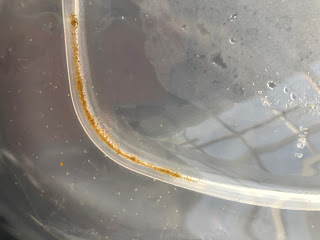Just keep swimming: part 2
I want to tell you about two more experiments I'm doing in Palau. At this point, if you're starting to get confused by all the different things my team has going on, don't worry, you're not alone. Even Maikani made a comment the other day in her signature exclamatory voice about the number of different experiments. It's a lot, I know. But can you blame me?
I want to figure out if Porites lobata larvae can disperse away from their home reef and colonize a new place. This is super important to understand because the heat-loving corals in the lagoons might have to repopulate outer reefs after a future bleaching event. If all the corals on the outer reefs are dead or bleached, could the larvae from inside the lagoons even make it out there? If they settle, could they survive? Does spending a long time drifting in the water lead to negative impacts later in life?
 |
| Porites larvae just love settling in the ridge at the bottom of my containers. Every brown dot is a little baby coral. |
Last year, I tried an experiment where I settled some larvae right away (as my control) and then settled some larvae few days later. I put all the tiles out right next to PICRC and took photos to monitor for growth and survival. I had this great plan to use the tiles in a heat stress experiment when I returned last November, but everything was dead. Fail.
So I'm trying again. I modified the experiment a bit in the hopes of getting my larvae to swim for longer. Last year, the difference between my control and my delayed treatment was only 2 days because the larvae started rebelling and settling on the bins. I had to move fast or lose my chance. This time, Matthew had the idea of using super finely-filtered seawater to remove any chemical cues that told larvae "there's a reef here; go ahead and settle." We were actually able to get the larvae to keep swimming for a week, which was awesome. I'm much more likely to see an effect in my experiment because the larvae had to keep swimming longer.
The other piece to this story is figuring out how long the larvae actually drift around in nature. I was super surprised last year when the larvae started settling after 2 days. There's tons of scientific papers that say Porites lobata larvae disperse really far because they already have symbionts from their mom. Basically, mom sent them away with an automatic food generator, so they're good to go for a while. If you look closely enough, though, all the claims of Porites having a super long pelagic larval duration are based on anecdotal evidence. There's one actual experiment from the 80s, and that seems to be about it. So how long do Porites larvae actually disperse?
Finding out should be pretty easy. I put some larvae in dishes, and I check on them every two days. Simple. I count how many have attached to the dish and how many are still swimming, and based on those data, I can make a curve of settlement probability. It really is that easy.
 |
| My first-attempt larval cultures. It's not surprising they heated up so much, I basically put them in little greenhouses. |
It's been almost two weeks now, and I still have some larvae swimming. Not a lot, but some. That's the thing, though - it doesn't take very many larvae to connect two populations. Even one immigrant per generation could keep their gene pools mixed. I have long suspected that pelagic larval duration is not a binary thing - it's not like all the larvae are swimming one day and settle the next. It's a curve. There's a distribution. Some larvae settle early, some much later. And those larvae that keep drifting around for weeks and weeks are the ones that can colonize all the isolated, island-like habitats I find so fascinating.
I am so excited about my experiments in larval duration and delayed metamorphosis. With these data for context, we can much better understand Porites lobata.
Comments
Post a Comment